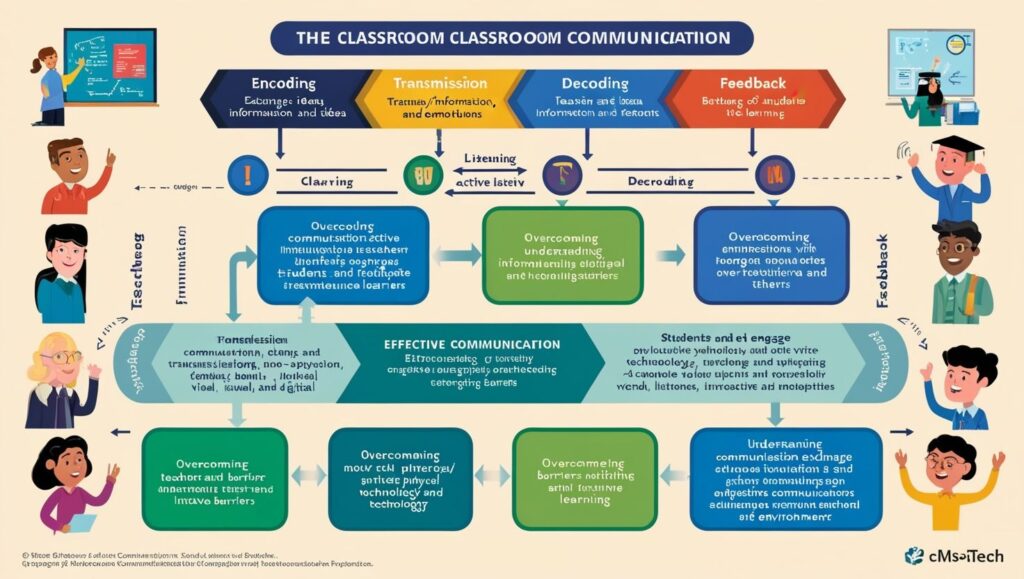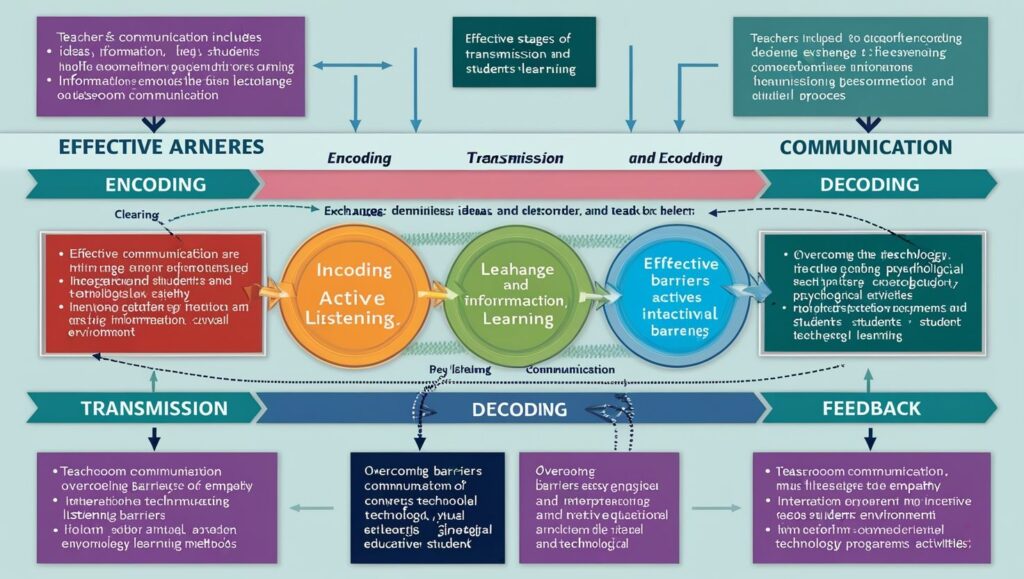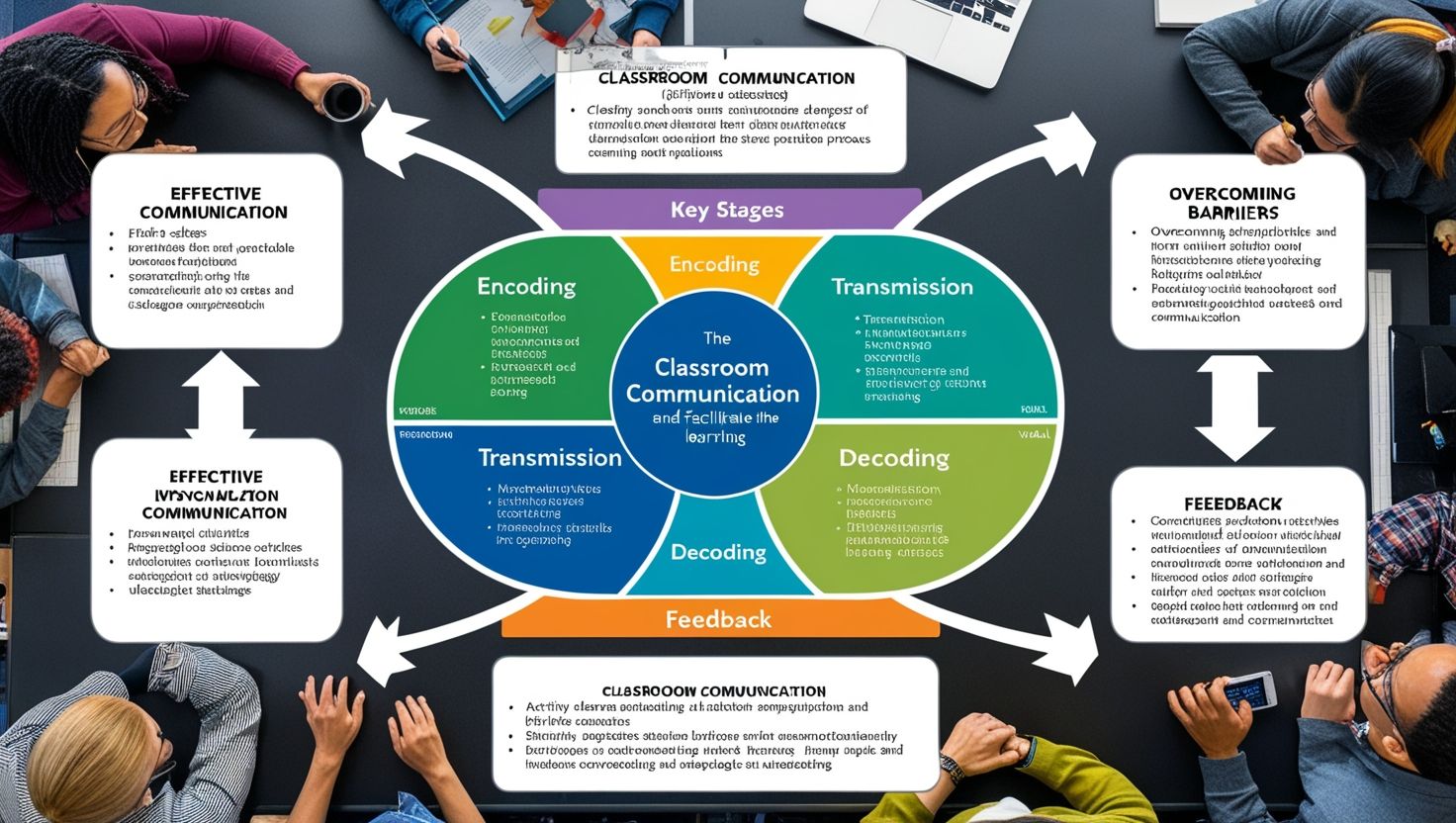Process of Classroom Communication, Effective classroom communication forms the backbone of a thriving educational environment. It encompasses the exchange of information, ideas, and emotions between teachers and students, facilitating learning and development. A well-structured communication process ensures clarity, engagement, and mutual understanding, empowering both educators and learners to achieve their goals. This article delves into the critical elements, stages, and methods of classroom communication, emphasizing its significance in fostering an inclusive and interactive educational atmosphere.
1. Understanding Classroom Communication
Classroom communication refers to the dynamic interaction between teachers and students during the educational process. It integrates verbal and non-verbal cues, creating a shared space for exchanging knowledge, opinions, and ideas. Successful communication in the classroom depends on factors such as clarity, active listening, and cultural sensitivity.
Key Elements of Classroom Communication
- Sender (Teacher/Student): Initiates the communication by encoding a message.
- Message: The content being communicated, including lessons, queries, or instructions.
- Channel: The medium used, such as spoken words, visuals, or digital platforms.
- Receiver (Teacher/Student): Decodes the message and provides feedback.
- Feedback: The receiver’s response, ensuring mutual understanding.
2. The Stages of Classroom Communication
The process of classroom communication unfolds in sequential stages:
a. Encoding
The sender formulates the message, deciding the language, tone, and medium to convey the intended meaning. For instance, a teacher explaining a concept might use diagrams, examples, and questions to engage students.
b. Transmission
The message is delivered through a chosen channel. Effective transmission in classrooms relies on clear articulation, appropriate teaching aids, and a supportive environment.
c. Decoding
The receiver interprets the message based on their prior knowledge, cognitive skills, and context. Teachers must ensure that students decode messages accurately by checking for understanding through questions or recaps.
d. Feedback
The receiver responds, completing the communication loop. Feedback in classrooms may be verbal (questions, answers) or non-verbal (nods, expressions), helping teachers assess comprehension and adjust their methods.
3. Types of Classroom Communication
a. Verbal Communication
This involves spoken or written language to share information. Effective verbal communication requires clarity, vocabulary suited to the audience, and an engaging tone. Examples include lectures, discussions, and written assignments.
b. Non-Verbal Communication
Non-verbal cues such as gestures, facial expressions, and body language convey emotions and reinforce verbal messages. A teacher’s enthusiastic demeanor, for instance, can motivate students.
c. Visual Communication
Using visual aids like charts, videos, and diagrams enhances understanding and retention. It appeals to visual learners, making complex concepts easier to grasp.
d. Digital Communication
Technology-driven communication includes emails, virtual classrooms, and educational apps. This mode has gained prominence with the rise of e-learning, offering flexibility and accessibility.

4. Barriers to Effective Classroom Communication
Despite its importance, classroom communication faces several challenges:
a. Physical Barriers
- Poor acoustics or inadequate seating arrangements hinder effective transmission of messages.
- Technological glitches in online classes disrupt the flow of communication.
b. Psychological Barriers
- Fear, anxiety, or a lack of confidence in students may prevent them from participating actively.
- Teachers’ biases or preconceived notions can affect how they interpret students’ feedback.
c. Semantic Barriers
- Misunderstanding due to ambiguous words or jargon can create confusion.
- Cultural differences in language and gestures may lead to miscommunication.
d. Technological Barriers
- Limited access to devices or digital literacy gaps may impede participation in virtual classrooms.
5. Strategies to Enhance Classroom Communication
a. Active Listening
Teachers and students should practice attentive listening, acknowledging and valuing each other’s perspectives. This builds trust and mutual respect.
b. Encouraging Participation
Interactive activities like group discussions, role-playing, and Q&A sessions engage students and make learning more dynamic.
c. Utilizing Technology
Incorporating tools like smartboards, online forums, and educational apps can cater to diverse learning styles and bridge communication gaps.
d. Continuous Feedback
Regular feedback helps identify areas for improvement. For example, formative assessments and one-on-one meetings ensure that students remain on track.
e. Developing Empathy
Understanding students’ backgrounds and emotional states fosters an inclusive environment, enabling effective communication.

6. The Role of Teachers in Classroom Communication
Teachers act as facilitators, guiding students through the learning process while adapting their communication styles to meet individual needs.
a. Clarity and Consistency
Teachers must articulate their expectations, instructions, and lessons with clarity. Repetition and reinforcement ensure comprehension.
b. Patience and Adaptability
Recognizing that students have different learning paces and styles, teachers should adapt their methods to suit diverse needs.
c. Building Rapport
Establishing a connection with students creates a comfortable atmosphere, encouraging them to express their thoughts without hesitation.
d. Promoting Critical Thinking
Teachers can use open-ended questions and debates to stimulate analytical skills and deeper understanding.
7. The Role of Students in Classroom Communication
a. Active Engagement
Students should take initiative by asking questions, participating in discussions, and seeking clarification when needed.
b. Respectful Interaction
Maintaining respect during communication fosters a harmonious learning environment. Listening attentively and responding constructively are crucial.
c. Peer Collaboration
Collaborative projects and group activities enhance communication skills and promote teamwork.
8. Technology and Modern Classroom Communication
The advent of digital tools has transformed traditional classroom communication. Platforms like Google Classroom, Zoom, and Kahoot offer innovative ways to interact and collaborate. However, the digital shift also requires teachers and students to develop technical skills and digital etiquette.
9. Measuring the Effectiveness of Classroom Communication
a. Observational Feedback
Teachers can observe students’ reactions and participation levels to gauge understanding and engagement.
b. Assessments and Surveys
Regular tests, quizzes, and feedback forms help measure the impact of communication strategies.
c. Peer Reviews
Encouraging peer feedback in group activities fosters self-reflection and collaborative improvement.
10. Conclusion
The process of classroom communication is integral to effective teaching and learning. By fostering open, clear, and inclusive exchanges, teachers and students can create a supportive and engaging educational environment. Overcoming barriers, leveraging technology, and emphasizing active participation are essential to enhancing communication. In a world of diverse learning needs, the art of effective classroom communication continues to evolve, shaping the future of education.

6 thoughts on “Process of Classroom Communication”
Comments are closed.